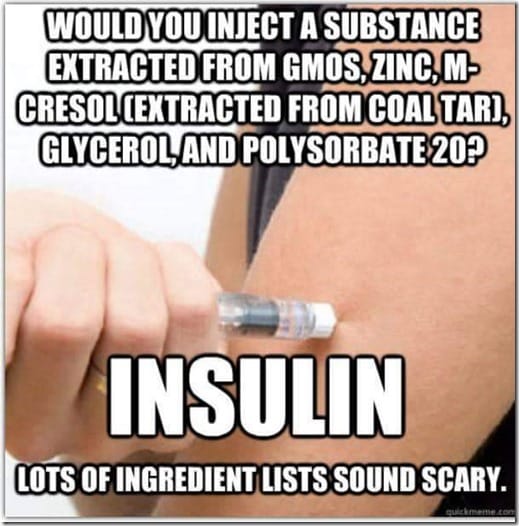The meme above is one of several that I have seen lately, and it points out how misinformed, and sometimes even deliberately misleading, some of the advocates of “healthy living” are. Frankly, most of the time they are simply incredibly misled and misinformed. They make the mistake of seeing the chemical name of some compound and immediately assuming that it is a synthetic man-made chemical. Or they find that the same chemical is found in some other toxic compound, or even find that the same chemical is dangerous to lethal in large quantities and therefore assume that it must be dangerous in every quantity. The meme above points out that the chemical names of the components of modern insulin, including the preservatives that keep it from spoiling, can sound quite daunting. And, as the meme points out, some of them are even derived from, gasp, coal-tar. Worse, m-cresol is even a precursor of a couple of insecticides. So, we must be injecting death into our bodies.
Of course, millions of insulin users have safely used insulin with m-cresol for decades with no toxic effects. However, that is not really what most natural advocates are missing. You see, m-cresol is also produced naturally by elephants in their temporal glands. Many plants also produce cresols. So, does this mean that m-cresol is not dangerous? Actually, the opposite is true. m-cresol, at a high enough level, can be a carcinogen. Wait, so people who inject insulin are injecting a carcinogen? The answer is yes and no, and this is where healthy living advocates makes their fatal mistake (yes, the pun was intended). The difference between helpful and harmful is often a matter of dosage. Every human being naturally produces chemical compounds that will kill them if they are out of balance with what the body actually needs. Many of the same chemical compounds are found in nature (whether in animals, plants, or minerals). What the healthy advocates often confuse is the difference between a healthy dose and an unhealthy dose of chemicals. And, I think they often forget that we are made of chemicals.
So, many of the healthy living campaigns that you see range from utterly misinformed to deliberately misleading. They are often run by apparently well-meaning people who are clueless, and know little of either biochemistry or science. They have looked up compounds in some book or other and concluded inappropriately that harm is being caused. After that, it is just a matter of collecting apocryphal tales, adding a layer of conspiracy theory, refusing the believe that if a study is not confirmed then there is no proved theory, and you have the makings of some of the campaigns that are actually damaging, rather than helpful, to the public health. Throw in a dash of occasional journalistic attention, and true harm can be done.
This is not to say that all campaigns are mistaken. The campaign against cigarettes is an excellent example of a good campaign that took many years to have effect. But, all too many of the modern campaigns do not have the scientific backing necessary to be on solid ground. All too many of them keep on running even when repeat studies do not back them. Especially among them are the type of campaign that quotes a chemical name—as I did above—and then shows how that chemical is a carcinogen, mutagen, or other –gen and uses that to claim that the chemical must be removed from some product or other. Many of those campaigns fail to mention that often the compound is found in nature, or is produced biologically in nature. Or worse, they may be even unaware of that. They also fail to mention what is often a vast difference between a therapeutic dose and the dose necessary for carcinogenesis or mutation to happen. Frankly, most of them show a stunning failure to understand how science and medicine function.
So, be careful when you “like” a meme or campaign on Facebook™ or other social media. Chances are the health campaign is simply wrong.




Leave a Reply